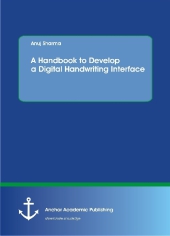 Neuerscheinungen 2016Stand: 2020-02-01 |
Schnellsuche
ISBN/Stichwort/Autor
|
Herderstraße 10
10625 Berlin
Tel.: 030 315 714 16
Fax 030 315 714 14
info@buchspektrum.de |

Anuj Sharma
A Handbook to Develop a Digital Handwriting Interface
2016. 176 S. 25 Abb. 220 mm
Verlag/Jahr: ANCHOR ACADEMIC PUBLISHING 2016
ISBN: 3-9606703-5-4 (3960670354)
Neue ISBN: 978-3-9606703-5-3 (9783960670353)
Preis und Lieferzeit: Bitte klicken
The prime purpose of this book is to educate readers for the development of a Digital Handwriting Interface (DHI) where the user can write with a digital pen. This book includes code in VC++.NET language. The developed DHI has been found very useful in many applications as sketch drawing, handwriting recognition research after inclusion of recognizer files and collection of digital handwriting. The reader will find this book useful as it includes the entire source code in chapter forms.
Text sample:
Chapter 3 PREPROCESSING DEVELOPMENT:
Preprocessing phase in online handwriting recognition is applied to remove noise present in input text due to hardware and software limitations vis-a-vis smooth handwriting. This noise exists in the input text in the form of sharp edges, non-centered text, uneven sizes of text and missing points in text trajectories due to high speed of handwriting and slants in characters. Preprocessing steps improve the overall recognition rate. It is one of the essential phases of online handwriting recognition and most of the researchers have discussed ist challenges for various scripts from time to time.
We have performed five essential preprocessing steps in online handwritten Gurmukhi character recognition. These preprocessing steps are discussed in Subsections 3.1 to 3.5. Fig. 3.1 represents input handwritten stroke before preprocessing [...].
As discussed in chapter 1, collected data is storage of pen movements in online handwriting recognition. These movements appear at various positions on viewport and joining these positions in first-cum-first-serve basis shows the appearance of drawn text. A character may consist of single or multiple strokes. The list formed in data collection includes nodes, where each node includes two fields, namely, point and stroke number. Here, the point represents x and y coordinates of view port and stroke number represents identity and sequential order of stroke. Also, stroke number helps in identifying similar points, gaps and crossings. If stroke 1 and stroke 2 include m_1 and m_2 points respectively, then the size ´n´ of the list will be m_1+m_2.
The pen movement consists of three functions, namely, PenDown, PenMove and PenUp. When one presses, moves, lifts the pen up consecutively, and more than one point collected, the stroke number is incremented. PenMove function stores movements of pen on writing pad. The points of the list are denoted by P_i (x,y),i=1,2,...,n; where n is total number of points in the list. For sake of brevity, we have used P_i for the point P_i (x,y) in various algorithms in this Chapter and subsequent Chapters. Let us also denote the x-coordinate of P_i (x,y) by P_(i_x ) and ist y-coordinate by P _(i_y ). PenUp indicates end of stroke and this process of storing the points is repeated till the last stroke. The data collected in this way is segmented at stroke level.
3.1 Size normalization and centering of stroke:
Size of the input stroke depends on how user moves the pen on writing pad. Stroke is not generally centered when the pen is moved along the border of writing pad. Size normalization and centering of stroke is a necessary process that should be performed in order to recognize a character. This can be achieved by comparing input stroke border frame with assumed fixed size frame and further can be moved along with the assumed center location.
Dr. Anuj Sharma holds a PhD in computer science in the field of Pattern Recognition and Machine Learning and has earned a Post-Doctoral fellowship from Germany. The author has written several research papers in the field of Pattern Recognition and Machine Learning. He has developed an Online Handwriting Recognizer as HWRAnuj. This book is an effort to present the digital handwriting interface of digital handwriting. Currently, the author is working as Assistant Professor at Panjab University, Chanigarh, India. Please find his updates at sites.google.com/site/anujsharma25.


